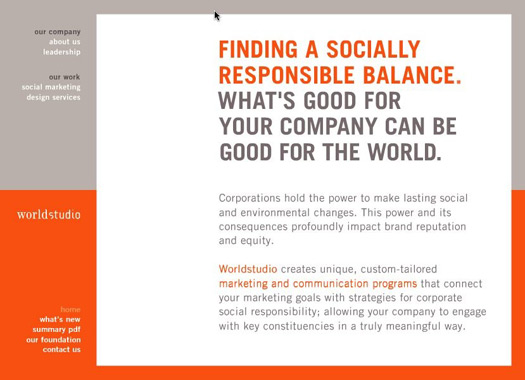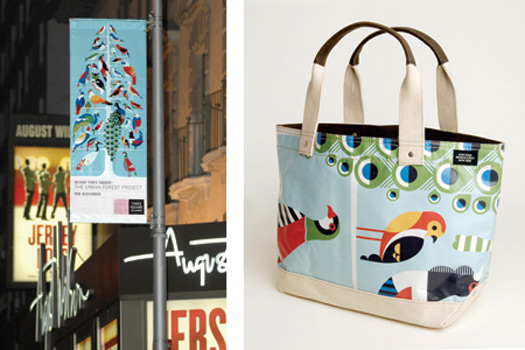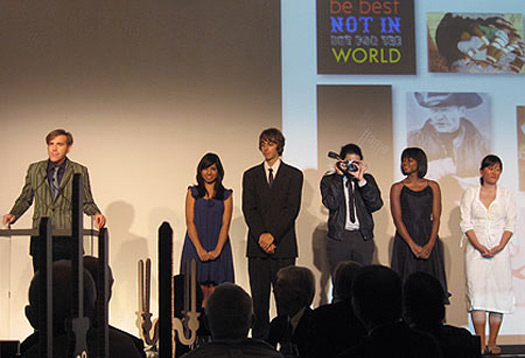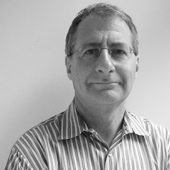
Worldstudio's home page
The website for Worldstudio, a New York-based design and marketing firm, proudly proclaims its dedication to promoting “lasting social and environmental changes” through design. Worldstudio, the site says, can help corporations “connect their marketing goals with strategies for corporate social responsibility.” Those core values are certainly part of the Worldstudio story, but social change isn’t the firm’s only business. Consider its logo and signage for a Mexican restaurant in Munich and packaging for a high-end tea company. The reality, says Worldstudio co-principal Mark Randall, is that these clients “pay part of the bills” in a multifaceted company whose client roster includes for-profit corporations, nonprofits and a nonprofit foundation dedicated to promoting social-change initiatives.
That makes good business sense, whether in a recession or a booming economy. At a time when corporate social responsibility, social entrepreneurship and design for social innovation are gaining ground, designers are seeking ways to engage in these activities — and to make a living while doing so. It isn’t easy. The usual route of pro-bono arrangements is not always productive or economically sustainable, these designers say. So they are experimenting with business and funding structures that provide a revenue and profit stream and allow them to engage in social-change projects.

The website for Worldstudio, a New York-based design and marketing firm, proudly proclaims its dedication to promoting “lasting social and environmental changes” through design. Worldstudio, the site says, can help corporations “connect their marketing goals with strategies for corporate social responsibility.” Those core values are certainly part of the Worldstudio story, but social change isn’t the firm’s only business. Consider its logo and signage for a Mexican restaurant in Munich and packaging for a high-end tea company. The reality, says Worldstudio co-principal Mark Randall, is that these clients “pay part of the bills” in a multifaceted company whose client roster includes for-profit corporations, nonprofits and a nonprofit foundation dedicated to promoting social-change initiatives.
That makes good business sense, whether in a recession or a booming economy. At a time when corporate social responsibility, social entrepreneurship and design for social innovation are gaining ground, designers are seeking ways to engage in these activities — and to make a living while doing so. It isn’t easy. The usual route of pro-bono arrangements is not always productive or economically sustainable, these designers say. So they are experimenting with business and funding structures that provide a revenue and profit stream and allow them to engage in social-change projects.

Worldstudio launched the Urban Forest Project in 2006, for which artists and designers create banners that communicate the idea or form of a tree. Shown here is Rob Alexander's Times Square banner recycled into a Jack Spade tote bag
Worldstudio, founded in 1993 by designer David Sterling, is a pioneer in that regard. Back then, Sterling conceived of a firm that “had the world as our studio,” he recalls. It was a place where designers could come together to create change because, as Sterling puts it, “designers shape the material world and therefore have tremendous responsibility.” Under Sterling and Randall, who later became a business partner, Worldstudio evolved into three units: one provided traditional design services for clients, another was involved in designing socially responsible educational products for children, and the third was a nonprofit foundation. Over time, “all three worked together,” says Sterling, adding that 10 percent of profits from the product line and client services went to the foundation. (Sterling left the firm eight years ago and now heads Worldstudio International, a design and consulting firm in Mérida, Mexico.)
Two years ago, when Andréa Pellegrino joined Randall at Worldstudio, a decision was made to push the social marketing side of the business. Now Worldstudio operates on four levels that support and leverage the others. It provides design services to for-profit clients — like the Mexican restaurant — and to companies with social-responsibility projects, such as Time Warner Music Group, which asked Worldstudio to devise ways to encourage employees to become more involved with environmental issues. It also provides similar services for nonprofits, like the Times Square Alliance, the city agency that runs Times Square. And finally the Worldstudio Foundation, a 501(c)(3) organization, initiates and seeks funding and financing for design and social-change programs. Design Ignites Change, for example, is a collaboration between Worldstudio foundation and the Adobe Foundation that encourages high school and college students to apply design thinking to problems in their community. And each year, Worldstudio AIGA scholarships are awarded to economically disadvantaged students to help support their education in art, architecture or design.

Worldstudio, founded in 1993 by designer David Sterling, is a pioneer in that regard. Back then, Sterling conceived of a firm that “had the world as our studio,” he recalls. It was a place where designers could come together to create change because, as Sterling puts it, “designers shape the material world and therefore have tremendous responsibility.” Under Sterling and Randall, who later became a business partner, Worldstudio evolved into three units: one provided traditional design services for clients, another was involved in designing socially responsible educational products for children, and the third was a nonprofit foundation. Over time, “all three worked together,” says Sterling, adding that 10 percent of profits from the product line and client services went to the foundation. (Sterling left the firm eight years ago and now heads Worldstudio International, a design and consulting firm in Mérida, Mexico.)
Two years ago, when Andréa Pellegrino joined Randall at Worldstudio, a decision was made to push the social marketing side of the business. Now Worldstudio operates on four levels that support and leverage the others. It provides design services to for-profit clients — like the Mexican restaurant — and to companies with social-responsibility projects, such as Time Warner Music Group, which asked Worldstudio to devise ways to encourage employees to become more involved with environmental issues. It also provides similar services for nonprofits, like the Times Square Alliance, the city agency that runs Times Square. And finally the Worldstudio Foundation, a 501(c)(3) organization, initiates and seeks funding and financing for design and social-change programs. Design Ignites Change, for example, is a collaboration between Worldstudio foundation and the Adobe Foundation that encourages high school and college students to apply design thinking to problems in their community. And each year, Worldstudio AIGA scholarships are awarded to economically disadvantaged students to help support their education in art, architecture or design.

"A Book By Its Cover: Reading Stereotypes," a student project designed to foster understanding between Arab and non-Arab communities in Kansas City, received an award in Worldstudio's 2009 Design Ignites Change program
The idea behind Worldstudio is to be a full-service marketing and design firm that has deep skills and experience in corporate social responsibility and social change but is not limited in any way to that specific sector. “Many of our clients have a socially responsible edge but we wouldn’t refuse a client without that edge,” explains Pellegrino, a co-principal, “We enjoy working with those clients but it is not the main criterion.”
Social-change clients, however, do enhance Worldstudio’s reputation, especially when it comes to its foundation work. Sara Davis, senior manager at the Adobe Foundation, financed by Adobe Systems Inc., says it supports the Design Ignites Change initiative in part because Worldstudio is an excellent strategic fit. Not only does its foundation’s nonprofit status make it possible to fund a project, but Worldstudio’s business savvy and “inside voice” in the social-change sector “gave us a sense of trust and respect,” Davis says. “We knew they could speak credibly because they come from that space.”

The idea behind Worldstudio is to be a full-service marketing and design firm that has deep skills and experience in corporate social responsibility and social change but is not limited in any way to that specific sector. “Many of our clients have a socially responsible edge but we wouldn’t refuse a client without that edge,” explains Pellegrino, a co-principal, “We enjoy working with those clients but it is not the main criterion.”
Social-change clients, however, do enhance Worldstudio’s reputation, especially when it comes to its foundation work. Sara Davis, senior manager at the Adobe Foundation, financed by Adobe Systems Inc., says it supports the Design Ignites Change initiative in part because Worldstudio is an excellent strategic fit. Not only does its foundation’s nonprofit status make it possible to fund a project, but Worldstudio’s business savvy and “inside voice” in the social-change sector “gave us a sense of trust and respect,” Davis says. “We knew they could speak credibly because they come from that space.”

Mark Randall (far left) presenting the 2008–2009 Worldstudio AIGA scholarships
Making money with a hybrid business model for a socially responsible design firm has always been tough (as well as squaring the ethical side of things), according to Sterling. “The concept for a model of getting clients involved in socially relevant design chugged along for years,” he says. “Meanwhile, we earned our keep by working for “the man” in traditional industries. We justifiably rationalized this, since clients were in fact helping subsidize the foundation and scholarship and mentoring programs.” In those years, he reckons, it was difficult to get clients to focus on anything but the bottom line, except for a few enlightened companies like Ben & Jerry’s.
Today’s environment has changed dramatically, and Worldstudio has attracted a wide range of clients on all sides of its business. But Randall says the jury is still out on whether the model could be termed a financial success. “We are holding our own and paying the bills and employees and the rent,” he allows. More important is whether design and social change can move beyond the “romance stage” and become economically viable in the long term. “There’s a lot of activity and conversations and tangible results but one of the biggest holes to fill is how to make it sustainable,” Pellegrino adds. “That’s still an open question which we are trying to answer.”
Making money with a hybrid business model for a socially responsible design firm has always been tough (as well as squaring the ethical side of things), according to Sterling. “The concept for a model of getting clients involved in socially relevant design chugged along for years,” he says. “Meanwhile, we earned our keep by working for “the man” in traditional industries. We justifiably rationalized this, since clients were in fact helping subsidize the foundation and scholarship and mentoring programs.” In those years, he reckons, it was difficult to get clients to focus on anything but the bottom line, except for a few enlightened companies like Ben & Jerry’s.
Today’s environment has changed dramatically, and Worldstudio has attracted a wide range of clients on all sides of its business. But Randall says the jury is still out on whether the model could be termed a financial success. “We are holding our own and paying the bills and employees and the rent,” he allows. More important is whether design and social change can move beyond the “romance stage” and become economically viable in the long term. “There’s a lot of activity and conversations and tangible results but one of the biggest holes to fill is how to make it sustainable,” Pellegrino adds. “That’s still an open question which we are trying to answer.”


Comments [1]
07.20.10
10:00